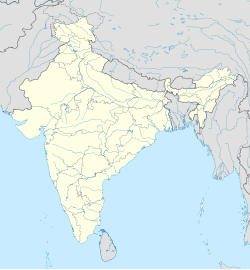Sogam Lolab
This article needs additional citations for verification. (March 2018) |
Sogam Lolab | |
|---|---|
| Sogam | |
 | |
Location in Jammu and Kashmir, India | |
| Coordinates: 34°29′50.8″N 74°22′51.8″E / 34.497444°N 74.381056°E[1] | |
| Country | |
| Union Territory | Jammu and Kashmir |
| District | Kupwara |
| Elevation | 1,696 m (5,564 ft) |
| Population | 16,166 |
| Languages | |
| • Official | Kashmiri, Urdu, Hindi, Dogri, English[2][3] |
| Time zone | UTC+5:30 (IST) |
| PIN | 193223 |
| Telephone code | 0195 |
| Vehicle registration | JK 09 |
| Sex ratio | 898 ♀/ 1000 ♂ |
| Literacy | 79.61% |
| Climate | Cfa |
| Precipitation | 710 millimetres (28 in) |
| Avg. summer temperature | 23.3 °C (73.9 °F) |
| Avg. winter temperature | 3.2 °C (37.8 °F) |
| Website | www |
Sogam Lolab is a municipality located in the Kupwara district of the Kashmir Valley, in the Indian union territory of Jammu and Kashmir. Sogam Lolab is a prominent town situated in the heart of the scenic Lolab Valley and holds significant administrative importance in the region. Functioning as the sub-district headquarters, Sogam serves as the central hub for governance and public administration for the surrounding villages and settlements within the valley. The town is home to various key government offices, including those for revenue, health, education, and rural development departments.
It is separated from Bandipora district to the east by the Nagmarg Meadows. Sogam is situated at an altitude of 1,589 metres (5,213 ft)[1] above sea level and has a population of approximately 16,166 with literacy rate of about 79.61%.
Geography
[edit]The Lolab Valley falls within the jurisdiction of Sogam Lolab, a sub-division of Kupwara. Lolab is a sub-district of Kupwara. It is bordered by the Kashmir Valley to the south and the Neelum Valley to the north and is separated Bandipora to the east by the Nagmarg Meadows.[4] The valley is formed by the flow of the Lahwal River, which runs from east to west. The Lolab Valley is home to many ancient springs and is covered with dense forests of deodar, kair, budul, pine, and fir.[5] Fruit trees such as apple, cherry, peach, apricot, and walnut are common in the valley, which is known as "the fruit bowl of Jammu and Kashmir".[6] The valley contains several natural landmarks and tourist spots, including the caves of Kalaroos and Green Meadows. The main villages in the Lolab Valley include Saiwan, Surigam, Putushai, Khumriyal, Sogam, Lalpora, Darpora, Cherkoot, Kalaroos, Wavoora, Maidanpora, Shalgund, Khurhama, Warnow, Aafan, Takipora, Cheepora, Goose.[7]
Ecology
[edit]Like other valleys in the region, Sogam Lolab is home to many Himalayan wild animals, including the Himalayan black bear, Himalayan brown bear, snow leopard, ibex, markhor, the hangul , and the musk deer.[8][9] The overall Lolab Valley, particularly Sogam Lolab, is adjacent to Kishenganga Valley, and separated by the Line of Control.[10] The Valley has witnessed many armed conflicts,[11][12] which have caused displacement of wild species and significant damage to the local environment and peopulation.
Educational Institutes
[edit]- Govt Boys Higher Secondary School Sogam[13]
- Govt Girls Higher Secondary School Sogam[14]
- Govt Degree College Sogam [15]
Notable people
[edit]- Shah Faesal - the first IAS topper from Kashmir, and a bureaucrat
- Mushtaq Ahmad Lone, Cabinet Minister, Politician
- Qaysar Jamshaid Lone, Politician, MLA Lolab
- Ghulam Nabi Wani - politician
References
[edit]- ^ a b "Maps, Weather, and Airports for Sogam, India". www.fallingrain.com. Retrieved 16 March 2018.
- ^ "The Jammu and Kashmir Official Languages Act, 2020" (PDF). The Gazette of India. 27 September 2020. Retrieved 27 September 2020.
- ^ "Parliament passes JK Official Languages Bill, 2020". Rising Kashmir. 23 September 2020. Retrieved 30 May 2021.
- ^ John Murray, 1906 (1906). Handbook to India, Burma, and Ceylon. John Murray. p. 253–. ISBN 978-8178350172.
{{cite book}}: ISBN / Date incompatibility (help)CS1 maint: numeric names: authors list (link) - ^ "Loalab Valley on Ikashmir". ikashmir.net. Retrieved 23 June 2012.
- ^ "Fruit bowl of J&K". india9.com. Retrieved 3 July 2012.
- ^ "Nagmarg Camping Cafeteria. · Dever Tekipora Rd, Diver Anderbugh, Jammu and Kashmir 193223". Nagmarg Camping Cafeteria. · Dever Tekipora Rd, Diver Anderbugh, Jammu and Kashmir 193223. Retrieved 21 January 2022.
- ^ Charles Ellison Bates (1980). A gazetteer of Kashmír and the adjacent districts of Kishtwar, Badrawár, Jamu, Naoshera, Punch, and the valley of the Kishen Gang. Light & Life Publishers. p. 26–.
- ^ "The HJ/70/15 Lolab The Hidden Himalayan Valley". The HJ/70/15 Lolab The Hidden Himalayan Valley. Retrieved 21 May 2025.
- ^ India Today Volume 25. Thomson Living Media India Ltd., 2000. 2000. pp. 53, 54–. ISBN 978-0674018174.
- ^ Outlook. Vol. 46. Hathway Investments Pvt Ltd. 2006. p. 162.
- ^ Sumantra Bose (2005). Kashmir: Roots of Conflict, Paths to Peace. Harvard University Press. p. 282. ISBN 978-0674018174.
- ^ https://schools.org.in/kupwara/01010800222/bhss-sogam.html
- ^ https://schools.org.in/kupwara/01010800204/ghss-sogam.html
- ^ https://www.gdcsogam.edu.in/


